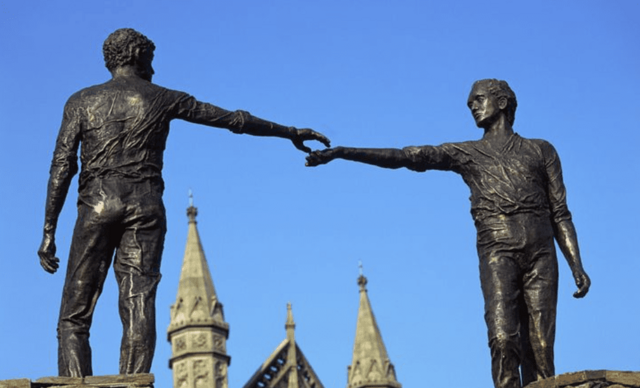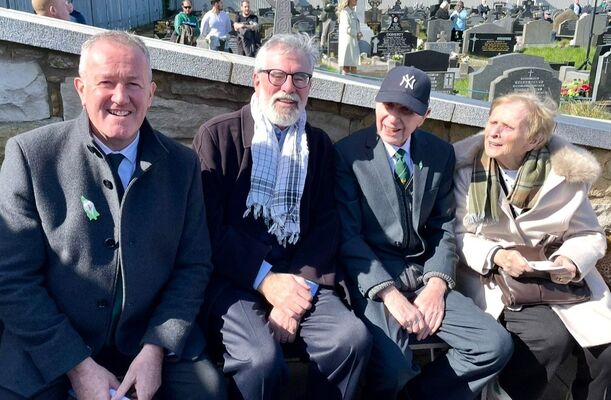BRITISH government policy toward Ireland has long been dictated by Britain’s strategic self-interests. From the conquest of Ireland nine centuries ago to partition, the needs of the people of Ireland have played no meaningful part in the decision making processes of a British state that focuses primarily on the interests of England and the English economy.
Consequently, Labour and Tory governments have each ensured that funding from Westminster has never been adequate to deal with the many social and economic demands of society here. The North – denied our right to our own fiscal powers – is a partitioned backwater that has consistently been at the bottom of London’s agenda.
This was highlighted again in recent days by the British Labour government’s decisions to deny funding for Casement Park for the 2028 Euros, its rejection of the Coroner’s request for a public inquiry into the killing of GAA official Sean Brown, and the pause in hundreds of millions in funding for the City and Growth Deal and its four infrastructure projects.
These decisions are evidence of the inequitable and narrow-minded attitude of successive British governments toward the people of the North. They are also a powerful argument in favour of the development of new constitutional arrangements that have the aim of building a new Ireland based on equality, respect and democratic values.
The fact that Casement Park would provide much-needed investment in the local economy and create substantial new jobs means nothing to a London establishment that simply doesn’t care.
I welcome the leadership shown by Cumann Lúthchleas Gael. The meeting on Monday between the GAA leadership and the British Secretary of State is timely. Antrim and Ulster deserve a Gaelic sports stadium. Belfast, the second largest city on the island, deserves a new Casement. The Gaels for Casement group, set up by the late Sean McGuinness, Brian White, Jane Adams and others, deserves the support of all sportspeople, whether we are Gaels or not.
I have no doubt that Casement will be built, but all of us have a duty to ensure that it’s done without further delay. The short-sightedness and stupidity of the London government should be the spur to make that happen. As soon as possible.
The refusal of the British to hold a public Inquiry into the killing of Sean Brown is particularly reprehensible. At the inquest it was revealed that 25 people, including state agents, had been linked to Mr Brown's murder and that surveillance on a key suspect – Mark Fulton – was suspended the night before the murder and reinstated the following day.
Six months ago the Coroner, Mr Justice Kinney, wrote to the British Secretary of State strongly calling for a public inquiry. He was unable to complete the inquest due to the delaying tactics of British state agencies, their introduction of five Public Interest Immunity Certificates, and refusal to publish relevant documents.
Mr Justice Kinney said: “I remain of the view that the appropriate way to deal with the investigation of the death of Mr Brown is through a public inquiry established under the Inquiries Act 2005.”
This column makes no apology for believing the people of the island of Ireland have the right to self-determination. But there is now a growing body of public opinion beyond Irish republicans who believe that the current constitutional arrangements are not working. On the contrary it is self-evident – as evidenced by the recent decisions – that the union with Britain works to our disadvantage. We therefore need to honestly, respectfully, and publicly encourage a conversation that looks beyond the current deeply flawed constitutional arrangements and examine the enormous potential that Irish unity offers.
Achieving a United Ireland peacefully and democratically is now a doable project. The Good Friday Agreement provides the means – through the unity referendums – to achieve a united Ireland. The all-party Oireachtas Committee on the Good Friday Agreement in its July report mapped out how it can be advanced. It concluded that the Irish government has to begin the “preparation for a united Ireland immediately”.
Labour leaders
LAST week the biggest ever delegation of American Labour leaders visited Belfast to take part in the fifth birthday celebrations of Áras Uí Chonghaile – the James Connolly Visitor Centre on the Falls Road.
In 2019, Uachtarán na hÉireann Michael D. Higgins formally opened the centre and since then it has become a mainstay for political tourism and international visitors to West Belfast. Almost 100,000 people have visited the centre and many have participated in the Áras talks, debates and discussions. Others have enjoyed the popular music events. The Labour leaders – which included the Presidents of some of the most powerful trade unions in the USA – contributed to the initial construction of the centre and have supported it in the years since then. Some, like Terry O’Sullivan of LiUNA and John Samuelson of the Transport Workers Union, were involved from the initial concept back in 2016.
VISIT: Gerry Adams with US union leader Terry O’Sullivan
Those who conceived of Áras Uí Chonghaile were ably assisted by our late comrade Rita O’Hare, who was for many years Sinn Féin’s representative in the USA and Canada. Rita built up an extensive list of contacts within the Labour movement and she worked closely with those involved to maximise the engagement.
At the heart of Áras Uí Chonghaile is the story of James Connolly, who spent seven years in the USA before returning to Ireland and to Belfast where he lived until the 1916 Easter Rising. Áras Uí Chonghaile tells his story through an immersive audio tour and interactive exhibition, from his birth in Edinburgh to his time in Ireland and the USA and to Belfast. The exhibition is one of the best I’ve seen and I would recommend readers to take the opportunity and visit Áras Uí Chonghaile – you won’t be disappointed.
I look forward to the next five years of this unique visitor centre.
Stamp of approval
SHANE MacGowan’s wife Victoria Mary Clarke very kindly invited me last Wednesday to join her and the family at a very special event to honour Shane and three other great Irish musicians. An Post had decided to issue a collection of four new stamps recognising the talents of four of our best known musicians – Shane MacGowan, Sinéad O’Connor, Christy Dignam and Séamus Begley – and recognising their significant contributions to Irish life and music.
Entitled ‘Iconic Irish Voices/Guthanna Éireannacha Locónacha’, the commemorative stamps contain four striking black and white images of the musicians.
The event was held in the new GPO headquarters beside the 3 Arena on the Quays in Dublin. The docklands, Aviva stadium and the Wicklow Mountains provided a striking backdrop to the event, which was held on the top floor. David McRedmond, Chief Executive of An Post, spoke of the four “proud Irish artists whose work explored, often critically, our identity as a people. We are greatly honoured on behalf of the people of Ireland to release these special stamps as symbol of the nation’s respect and pride in their musical genius and their impact on the world.”

Victoria Mary said Shane would be very proud to be honoured along with the other musicians. She said: “He was a passionate Irishman with a huge love for Ireland and its history and culture... he saw the Irish postage stamps as symbolic of our freedom from Britain and our status as an independent republic... his family are all very grateful to An Post for this beautiful gesture.”
The other families also spoke of their pride in their loved ones being remembered and honoured as part of this exceptional collection.
The new stamp collection is now available online at anpost.com/IrishVoices and in selected post 0ffices across the state.








